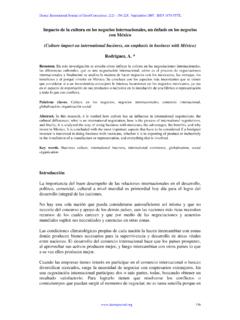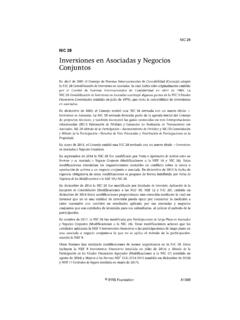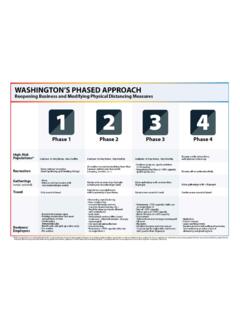Transcription of BUSINESS CONTINUITY PLANNING GUIDELINES
1 BUSINESS CONTINUITY PLANNING GUIDELINES February 2020 BUSINESS CONTINUITY PLANNING GUIDELINES 2 BUSINESS CONTINUITY PLANNING A PRACTICAL APPROACH FOR RC/RC EMERGENCY PREPAREDNESS, CRISIS MANAGEMENT, AND DISASTER RECOVERY Introduction BUSINESS CONTINUITY Technical Group (BCTG) Scope Preparedness Mitigation Response Recovery Training & Maintenance References/Bibliography Appendix A - Terminology Appendix B BC Guideline Checklist Separate Attachment BC PLANNING Matrix Template: Delegation of Responsibilities & Assignments Hibernation Plan Template. 3 Introduction The overall goal of this PLANNING guide is to provide guidance to the Federation Secretariat and Red Cross/Red Crescent Societies about the importance of BUSINESS CONTINUITY PLANNING , which establishes the basis for the organization to continue functioning during the crises, and recover and resume BUSINESS processes when programs have been disrupted unexpectedly.
2 Because RC/RC societies play a crucial role in the overall emergency disaster response, disruptions in service should be minimized in order to maintain public trust and confidence in the RC/RC emergency response capabilities. As such, RC/RC management should incorporate BUSINESS CONTINUITY considerations into the overall design of their emergency response model to proactively mitigate the risk of program disruptions. This PLANNING guide is an assembly of existing standard operating procedures, plans and best practises that will explore the key components of a BUSINESS CONTINUITY PLANNING process. It will also provide a high-level framework for the creation, implementation, and maintenance of a BUSINESS CONTINUITY Plan (BCP).
3 BUSINESS CONTINUITY PLANNING Team (BCPT) Every office of the IFRC Secretariat and possibly every National Society should create a BUSINESS CONTINUITY PLANNING team. As a preeminent organization in disaster preparedness and response, the Federation has an important role to play in emergency response, whether from natural disaster, accidents, or planned actions. By addressing specific concerns and issues inherent to disaster risk management, the BUSINESS CONTINUITY PLANNING Guide will better serve the needs of the Federation Secretariat and RC/RC National Societies by increasing the effectiveness of its programs. For the specific Coronavirus (2019-nCoV) pandemic preparedness, inside the recently establish coordination cell, a tailored support on BCP is present.
4 All the BCP need to be linked with the contingency plan and the multi hazard preparedness activities aligned with the preparedness for the effective response (PER) concept. Scope The BUSINESS CONTINUITY (BC) PLANNING Guideline is applicable to all IFRC Secretariat office and National Societies and can be adjusted depending on the context of the region and / or the emergency. The BC Guideline is a series of interrelated processes and activities that will assist in creating, testing, and maintaining an organization-wide plan for use in the event of a crisis that threatens the viability and CONTINUITY of the RC/RC activities. 4 PHASE 1 - PREPARATION Objective: The first phase of the BCP process is concerned with forward PLANNING (Preparation), to provide a strong foundation on which to build a BCP.
5 At the end of this phase, the following documents will have been created. Tasks: 1. Assign Accountability Organizational Policy BUSINESS CONTINUITY PLANNING Team Delegation of Responsibilities Communicate BCP 2. Perform Risk Assessment Risk Management Process Threats are identified Vulnerabilities are identified Risk Assessment Security Standards 3. Conduct BUSINESS Impact Analysis Review Types of Risks and the possible Impact on the Organization 4. Agree on Strategic Plans Identify Critical Processes Assess Impact if Crisis Were to Happen Determine Maximum Allowable Down-time and Recovery Time Objectives Contingency Plans; Relocation and Hibernation Alternative Sites of Operation Identify Resources Required for Resumption and Recovery 5.
6 Crises Management Development Crises management Crises management team composition Contact Information Assign Accountability It is the responsibility of the Senior management to support not only the PLANNING process but also the development of the infrastructure to install, maintain, and implement the (BCP). This will ensure that management and staff at all levels within the organization understand that the BCP is a critical top management priority. Organizational Policy The senior management should establish policies that define how the organization will manage and control the risks that were identified. In the event of a crisis, an organization wide BCP Policy should be committed to undertaking all reasonable and appropriate steps to protect people, property, and program interests are essential.
7 The policy should include a definition of a crisis. BUSINESS CONTINUITY PLANNING Team (BCPT) Based on the Risk assessment and BUSINESS Impact Analysis (BIA), a BUSINESS CONTINUITY PLANNING Team with responsibility for BCP development that includes senior managers from all major departments and volunteer groups should be appointed to ensure wide-spread acceptance of the BCP. 5 Delegation of Responsibilities This section should clearly identify the key staff and the delegation of responsibilities for systems, plans, and resources availability. In Appendix C, is the proposed matrix to clearly create and oversee the delegation and responsibilities of tasks.
8 In addition, the plan should specifically identify the key personnel that are needed for successful implementation of the BCP. Plans should assign responsibilities to back-up personnel in the event key employees are not available. Communicate the BCP The BCP should be communicated throughout the organization, to ensure all departments are aware of the BCP structure and their roles within the plan. Risk Management Process The documentation created by this task is the key driver for the determination of the BCP strategy and the creation of the BC plan. In this task, risks are identified, prioritized, and managed; and the overall BUSINESS impact of the risks is assessed.
9 In order to create a safer environment, many factors must be considered. The figure below depicts the risk management process, presented to help illustrate the recommended steps for effective risk management. Step 1 Step 2 Step 3 Step 4 Step 5 Threat Assessment The first step in a risk management program is a threat assessment. A threat assessment considers the full spectrum of threats ( , natural, man-made, criminal, militant, accidental, etc.) for a given location. The assessment should examine supporting information to evaluate the likelihood of occurrence for each threat.
10 For natural threats, historical data concerning frequency of occurrence for given natural disasters such as tornadoes, hurricanes, floods, fire, or earthquakes can be used to determine the credibility of the given threat. For criminal threats, the crime rates in the surrounding area provide a good indicator of the type of criminal activity that may threaten the facility. In addition, the type of assets and/or activity your organization is conducting may also increase the target attractiveness in the eyes of the aggressor. Each RC/RC organization and individual operation will be different. The threats and vulnerabilities will therefore be context-specific, as the risk will also be specific to a particular operation.









